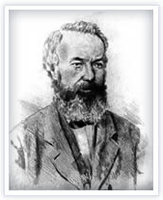










Alexander Bain was a Scottish inventor and engineer who was first to invent and patent the electric clock. He installed the railway telegraph lines between Edinburgh and Glasgow.
Early life
Bain was born in Watten, Caithness, Scotland. His father was a crofter. He had a twin sister, Margaret, and, in total, he had six sisters and six brothers. Bain did not excel in school and was apprenticed to a clockmaker in Wick.Having learned the art of clockmaking, he went to Edinburgh, and in 1837 to London, where he obtained work as a journeyman in Clerkenwell.Bain frequented the lectures at the Polytechnic Institution and the Adelaide Gallery and later constructed his own workshop in Hanover Street.
Facsimile machine
Bain worked on an experimental facsimile machine in 1843 to 1846. He used a clock to synchronise the movement of two pendulums for line-by-line scanning of a message. For transmission, Bain applied metal pins arranged on a cylinder made of insulating material. An electric probe that transmitted on-off pulses then scanned the pins. The message was reproduced at the receiving station on electrochemically sensitive paper impregnated with a chemical solution similar to that developed for his chemical telegraph. In his patent description dated 27 May 1843 for "improvements in producing and regulating electric currents and improvements in timepieces, and in electric printing, and signal telegraphs," he claimed that "a copy of any other surface composed of conducting and non-conducting materials can be taken by these means".The transmitter and receiver were connected by five wires. In 1850 he applied for an improved version but was too late, as Frederick Bakewell had obtained a patent for his superior "image telegraph" two years earlier in 1848.
Bain's and Bakewell's laboratory mechanisms reproduced poor quality images and were not viable systems because the transmitter and receiver were never truly synchronized. In 1861, the first practical operating electro-mechanical commercially exploited telefax machine, the Pantelegraph, was invented by the Italian physicist Giovanni Caselli. He introduced the first commercial telefax service between Paris and Lyon at least 11 years before the invention of workable telephones.
Later life
Initially Bain made a considerable sum from his inventions but lost his wealth in poor investments. In 1873, Sir William Thomson, Sir William Siemens, Latimer Clark and others obtained a Civil List pension for Bain from Prime Minister William Ewart Gladstone of £80 per year.
Bain was buried in the Auld Aisle Cemetery, Kirkintilloch. It was restored in 1959. The headstone (pictured here) had a fallacious date of death (1876) which was later corrected to 1877. A pub in Wick, close to where Alexander Bain served his apprenticeship, is now named after the inventor. Also, as a tribute to his inventions, the main BT building in Glasgow is named Alexander Bain House. One of the earliest examples of an electrically impulsed pendulum clock is on display at the Deutsches Uhrenmuseum.